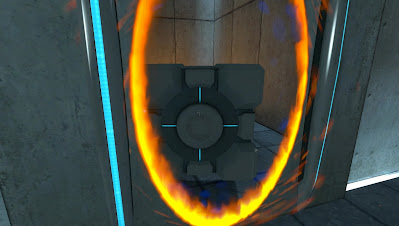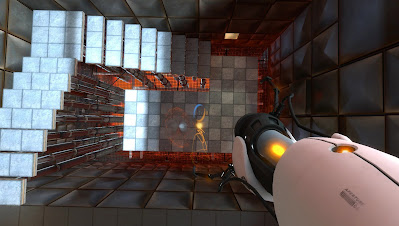When you impress the boss at Valve with a little puzzle game called Narbacula Drop, you get rewarded with a new job and the resources to make it truly shine. When Portal is completed a few years later, it's boxed up with a bunch of other Valve titles in The Orange Box as a side attraction for those who have finished Half-Life 2 or are frustrated by Team Fortress 2, where it somehow becomes the talking point of 2007.
The Cake is a Lie. Now you're thinking with Portals. The Weighted Companion Cube. Still Alive. You didn't have to even play Portal to know what these were, or how some of the lines to Still Alive go. This stuff was everywhere, as inescapable as GLaDOS would have you believe Aperture Science Labs were.
What do you mean "What's GLaDOS?"
Fond Memories
My first direct experience with Half-Life 2 was in The Orange Box for the PlayStation 3, which wasn't ideal but it was all I had. Well, no, I briefly had it on Mac OS X, but really didn't play that version at all. Anyway, having The Orange Box meant having Portal, and so my first experience with this first-person portal puzzle platformer was with a PlayStation 3 controller.
Let's just say that I never finished it. I got far, I think, but there came a point where either my brain stopped working, or my thumbs weren't fast enough to manipulate the analogue sticks and my fingers not responsive enough to fire off a well-timed portal to stop me from falling to my death. I ran out of steam, so to speak, and abandoned it.
Of course, you can never really ignore Portal these days...
Fun Times
PC Portal in hand, I was finally able to experience it as it was meant to be played, with a keyboard and mouse. You can tell because it has that iconic or maybe infamous Valve/Source engine menu, which I've never really liked. Feels cold and uninviting, more functional than pretty.
Probably very apt, then, that it's used in Portal, where we awake to find ourselves the next test subject in the Aperture Science Laboratories Computer-Aided Encirchment Center, and are welcomed by the synthetic voice of GLaDOS, described as passive-aggressive, witty, narcissistic, and sinister, according to Wikipedia. That's more than I could come up with. I was going to go with sarcastic, but that alone doesn't cover the sheer breadth of emotions she relates to us through our journey.
What is our journey, anyway? Awaking in what is essentially a jail cell with a countdown timer looming over us on the wall. GLaDOS is introducing us to some tests, as per her usual routine I'm sure, before a huge orange portal appears on the wall.
Games have used teleporting and whatnot before, but Portal has taken that to such an extreme that I'm not even going to try and read up on how it works. It just boggles my tiny little mind, and as you can imagine, a great many minds in late 2007, as the video gaming world started to see that this was no longer a cool tech demo of a game, but a fully-fledged, humourous, seeping giant of a game.
This will, in the early stages, involve you picking up heavy boxes to keep buttons pressed down to open doors for you to walk through, as you wait patiently on useful portals to open so that you can step through, box in hand, to where you need to be at a moments notice, all to the sounds of GLaDOS congratulating [insert subject name here] on their success.
These early tests are simple tutorials for movement and interaction, but wouldn't it be nice to have a device that allowed us to create our own portals?
Aperture Science Handheld Portal Device in hand - don't look down the business end - we're able to have a little bit of say in how we complete levels from here on. It's now the turn of the orange portals to wait for us to connect them to a blue portal, fired at whatever flat white wall, floor, or ceiling we need them to be stuck on.
If you can tell from the screenshot above, this also makes for some brain scrambling imagery, as you try to work out what you're looking at before falling through the floor to emerge standing up next to a wall, boxes clipping and clattering with the scenery in that Source engine fashion that always feels like being one step away from glitching through the geometry or exploding in your face.
But through the puzzles we go, learning the simple controls and new challenges on step at a time. Our jump is more of a little hop, dirty floors are bad, balls of plasma or whatever being shot out of the walls need to be re-routed to complete circuits to open doors... so far, so puzzly.
I'd been through all of these on the PS3, long ago, and they weren't too challenging. I probably could have done them more efficiently, and having seen speedruns, my efforts were pathetic in comparison, but Portal was much as I expected it to be: a well-made game, distinctly Source-y in nature, with a narrator ready, willing, and able to quip at a moment's notice.
But I really want the ability to create orange portals, too. That'll give me my freedom - within the confines of the Aperture Labs, at least.
And soon we see it, on a platform in the middle of an instadeath pool of dirty water, locked behind buttons and platforms and perilous puzzles. Well, perilous if you fail. Head scratching otherwise. Anyway, it's a good job we get the second portal for our gun because you're going to need one when hurtling to the floor face first.
You'll need to learn how to use portals in many ways (duh), and one of those ways involves trust falls. Plop a portal near the roof, one underneath your feet, and learn the hard way that speedy thing goes in, speedy things come out.
It's vital because you'll need to throw yourself over walls and across gaps using your portal-induced momentum. Do portals give you any momentum? Hmm. More testing needed, I think.
Frustrations
I was going to play Portal until one of two things happened: I got stuck or I died. I've never completed Portal, but I've seen it, and know the gist of it, so if I didn't get through this short game here and now, no worries, it's not like I'm missing anything.
Sadly, opening up a portal beneath a plasma ball when you're standing next to the other portal is an utterly stupid idea, and I managed to shoot myself in the back of my own head, so that was my Portal run.
I didn't get to dodge my way around cute but incredibly deadly robotic turrets. I didn't get to take the Companion Cube through a level. I didn't even get to see the environmental storytelling left being by previous test subjects, literally breaking through the walls of the test chamber to tell me that the cake is a lie.
Really? The cake? It's a lie?
Final Words
I played on the next day, making slow but steady progress through a few more levels before I got the merest hint of motion sickness and called it time. But maybe my brain just ached trying to work out some of the puzzles. Whatever the reason, I did get to see the real Portal.
If you don't know, Aperture Labs is rather empty these days - abandoned, even. But GLaDOS is still here and going mad and evil in a not-so-subtle attempt to kill you, presumably for no reason other than that she can.
On the surface, Portal is a platform puzzler, but you soon see that there's much more substance underneath that surface. There's a rich story to explore, though it may only last for an afternoon, voiced exceptionally well by singer Ellen McLain as the psychotic GLaDOS, a video game character that near-immediately shot up the rankings in lists of the best, funniest, evilest characters, and more besides.
There's a reason Portal memes were everywhere - Portal was so damn good. An experience like nothing else video gaming offered. A first-person platform puzzler that was challenging, funny, and completable in a short span of time. A package where every little piece came together into something exceptional that lived long in the memory.
I've every intention to try and finish it this time. I'm late to the party and probably won't get any cake, but at least I'll have survived whatever GLaDOS could throw at me before getting turned into a potato in the sequel. Oh yeah, of course there's a sequel. Too late for this 1001 list though.
If you've no played Portal, it's a no brainer, which is what you may well be left with when you've finished playing with it.
FILLING YOU IN
So it turns out I left my second session at the end of test 17, where I learned that test 18 was the test I gave up on when playing Portal on the PS3. After a few blissfully easy minutes of mouse movement, I was onto the final test, after an hour or so of gameplay overall. I was that close to finishing way back then. Guh.
Anyway, test 19 is where you escape, or certainly make a damn good effort of doing so, working through the grubby interior of the Aperture Labs they don't want you to see before finally dealing with GLaDOS by chucking bits of her into an incinerator as she tries to poison you with lethal nerve gas. As boss fights go, it's not the greatest, but it is the first to make use of portals... Probably.
The final cutscene was altered when news of Portal 2 came out, to better join the two together. Bonus fun fact for you there. Still, Steam says I've spent 2.3 hours with this, and what a nice 2.3 hours it was.
Fun Facts
One of the writers, Erik Wolpaw, on Portal's cake: "At the beginning of the Portal development process, we sat down as a group to decide what philosopher or school of philosophy our game would be based on. That was followed by about 15 minutes of silence and then someone mentioned that a lot of people like cake."
Portal, developed by Valve, first released in 2007.
Version played: The Orange Box, PlayStation 3, 2007, via memory.
PC, 2007.


























